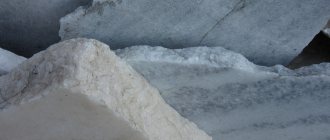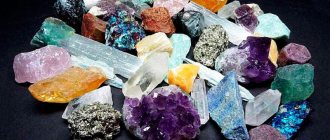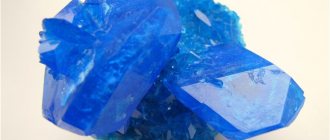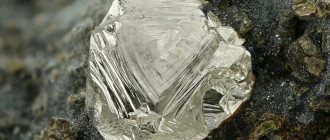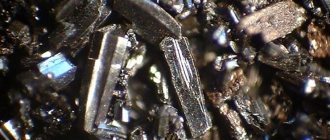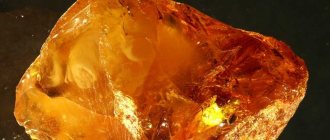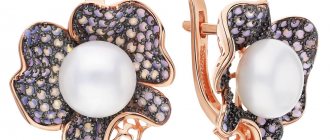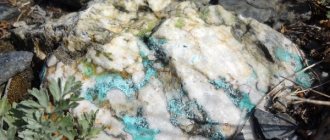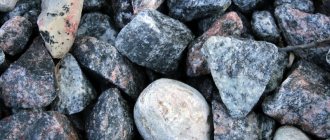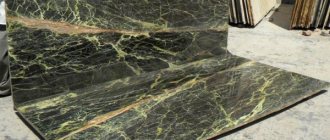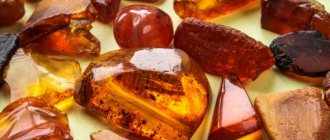Marble is a type of rock formed through the crystalline transformation of dolomite and limestone. Translated from Latin, “marble” means “shiny stone.”
A durable carbonate conglomerate containing many minerals and organic matter, it is easy to cut and polish. This allows it to be used in many industries - construction, art, crafts and architecture.
Natural marble comes in many varieties depending on color and origin. The color characteristics of the stone are influenced by impurities that are part of the main composition of the rock. The crystalline structure of marble provides variation in patterns, which is also influenced by the direction of cutting the monolith.
The history of marble goes back to the centuries of antiquity. The peoples of Ancient Greece and Rome discovered a unique material that, in addition to its beautiful appearance, was strong, durable, and at the same time easy to process. Temples to the gods, sanctuaries and palaces were built from it.
Types of marble and its colors
Natural marble is a stone with amazing properties and a wide palette of shades. Its color and structure are directly dependent on the admixtures of minerals and organic matter.
- White. A unique stone, the color of which indicates the absence of additional impurities, is the main material for the manufacture of sculptures and figurines due to its easy processing and unusual appearance. Some examples of white stone have thin veins of different colors.
- Black. Rare volcanic rock mixed with bitumen or graphite is used as an exclusive finishing material. The most valuable are samples with golden inclusions or veins.
- Green. The color saturation and variety of shades depend on the amount of iron silicates (tremolite, serpentine) in the stone. Veins of white and brown shades are possible, which give the stone a wavy or branched pattern.
- Red. An expensive and unusual stone, the shades of which are provided by the presence of iron oxide in the composition. Acts as a strong and durable material that is easy to process. Temples and palaces were built from it in past centuries. Today it is an expensive finishing stone, which is used to decorate formal halls and premises.
- Grey. Fine- and coarse-grained stone may contain veins of gray colors (from light to deep dark), as well as dark yellow, white and pink shades. It is resistant to harmful influences, easy to process and polish.
- Beige. The warm shades of the stone (from almost white to light brown) and the intricate pattern on the surface provide an admixture of manganese and limonite. It has high strength, so it is often used for flooring and other surfaces exposed to mechanical stress.
- Pink. The saturation of the shade depends on the percentage of iron oxide in the rock. The structure of the pattern contains veins of dark shades of green. Various surface treatments make marble products unique and elegant.
Blue marble - Blue. The main background of this stone is white and gray colors. The blue tint is provided by the veins and the richness of their color.
- Blue. The rich blue color of this rare and expensive stone is provided by an admixture of diopside. Depending on the percentage of impurities in the main composition of the rock, colors can vary from dark blue to dark purple.
- Yellow. A bright and “warm” stone of sunny color with an unusual pattern created by golden shades and beige stains. Used for the manufacture of finishing tiles, window sills, countertops and decorative elements.
- Brown. It has a palette of shades from light brown to dark chocolate, which is manifested due to the admixture of iron carbonate, manganese and limonite in the main composition of the rock. Brown stone is characterized by the presence of a light pattern, which makes it unusual and beautiful.
Marble is also divided not only by color, but also by where it was mined. Below are the most popular and beautiful types of stone:
- Carrara marble. A unique milky-white stone, sometimes shimmering with a delicate blue tint, is mined near Carrara in the depths of the Apuan Alps. The most valuable type of marble from which the world's works of art are made. Michelangelo's famous sculptures are made from this snow-white mineral.
Carrara marble - Sayan marble. The stone of white, pink and cream colors with a wave-like pattern is mined in one of the oldest deposits in Russia - the Sayan mountain range. A hard, easy-to-work material from which many small-sized products are produced.
- Jurassic marble. Dense marbled limestone, which contains a high percentage of biological fossils (corals, algae, sponges), thanks to which the stone pattern acquires uniqueness and living beauty. The only deposit of stone is the Altmühltal park in Bavaria. The properties and essence of the rock are not marble, but it received its name in the Middle Ages due to its susceptibility to polishing.
- Ufaley marble. A stone with gray shades with a blue tint and white veins that form a striped pattern. It is used for the manufacture of architectural and decorative elements (vases, balls, statues and sculptures), and also acts as a beautiful facing material. Production is carried out in the Ufaleyskoye field in the Eastern Urals of Russia.
Mining equipment
In most cases, marble blocks are mined and processed using the following technique:
- stone cutting machines. Depending on the size of blocks required, rope or disc models are used;
- stone cutters with steel ropes acting as cutting elements that are used to cut large blocks;
- bar machines, which, due to the presence of a long blade (from 3.2 to 3.6 m), are used to produce large blocks;
- circular saws without teeth, designed for cutting medium-sized and very small blocks.
The productivity of stone processing machines is increased by reinforcing their cutting parts. This technique has several saws, with which you can make both horizontal and vertical cuts. Many of the equipment models are equipped with a system that allows you to automatically move along the entire face on rails.
Mineral deposits
There are a large number of deposits in the world rich in marble deposits. The most famous and valuable is white marble, which is mined in Tuscany in the vicinity of Carrara. Deposits of Parian stone of yellow shades are located in Greece.
Rock mining is carried out in Cuba, Norway and France. In the USA, significant marble deposits are found in the Appalachians, in South Africa - in Natal.
Minor mining of this amazing stone is carried out in Russia. These are the Kibik Kordon, Pershinskoye and Koelga fields, located in the regions of the Eastern Urals. Marble was also discovered in Southern Yakutia, in the Irkutsk Territory and on the territory of the Kola Peninsula, but its development has practically not been developed.
The eastern CIS countries – Georgia, Armenia and Uzbekistan – are rich in marble deposits. The Ijevan, Khorvirab and Agrevan deposits, located on the territory of Armenia, are rich in black, brown and pink samples. The gray and red rock is mined in the Saliet and Molitsky deposits of Georgia. Uzbekistan has a large number of deposits of unique marble colors. The Gazgan deposit is known for the extraction of marble in pink and cream shades, the Aman-Kutan deposit for large crystals of gray and pink colors. Unique examples of fine-grained white marble, which gemologists place in a position higher than Carrara, are mined in the Malguzar deposit.
In Ukraine, Crimea, Transcarpathia and the Donetsk region are famous for marble deposits.
Marble deposits are in the European part and the Central region.
In the central European part of Russia, marble is quite rare; its main deposits are found in Karelia.
On the northern coast of Lake Ladoga there is the Ruskealskoye deposit of greenish-gray marbles, in the Onega region there is the Belogorskoye group of deposits of pink dolomitized marbles (Belogorskoye, Vongubskoye, Limzhozerskoye, Krasnogorskoye, Ershov Kryazh). The marbles from the listed deposits can, in a certain sense, be called “historical”: most of them were mined from the mid-18th century. and was widely used in the artistic decoration of palaces and churches in St. Petersburg. In the same area there is the Kovadyarvinskoe deposit of green-gray and brownish-gray serpentinite marbles.
Artificial marble
An alternative to natural mountain stone has become artificial marble, which has similar properties and completely imitates the pattern and color of the rock. Many products are made from artificial stone, from countertops, window sills, stairs, steps and bathtubs to sculptures and various decorative elements.
There are several types of artificial marble:
- Casting is the most popular composite material, which may include quartz sand and marble chips, and can imitate natural marble, granite, jasper and onyx.
Oselkovy artificial marble - Oselkovy is a colored gypsum mass into which adhesive water is added. Marble plaster has a mirror-like shine and can imitate many types of natural stone. This is a lightweight finishing material that has high strength and an unusual appearance;
- Ground (crushed) – white marble crushed into powder, which is used for the production of paper, plastics, cleaning agents with abrasive inclusions;
- Liquid marble is a new product in the field of finishing materials, which is a thin flexible canvas. It is used for internal and external wall cladding. The result is a seamless, flat surface.
Artificial marble has some advantages over natural stone. It is easy to process, resistant to chemicals and stains, durable, and does not absorb moisture.
This is a non-porous and environmentally friendly material that has a beautiful decorative appearance with a uniform surface. It is the latter property that distinguishes artificial stone from natural marble, making its pattern too “correct”.
Development technology
Marble extraction is most often carried out by open-pit mining in quarries. Only sometimes this material is obtained by development in mines. In most cases, the development process involves the following stages of work:
- Rocks that are not subject to further processing are removed from the slaughter.
- The stone block is separated from the marble mass using suitable stone-cutting machines.
- The marble monolith is transported to the place where it will be further processed.
- The stone block is sawed or split into blocks of suitable size.
- The resulting blocks are processed to obtain material with suitable dimensions.
- Grinding of stone blocks using special machines with the additional use of a mixture of water and sand.
- Final polishing with tin oxide and oxalic acid, which are applied to the surface using a special wheel.
- Marble blocks and chips are transported to places of sale or further processing.
Finishing methods
Marble blocks that go on sale and have high aesthetic qualities are obtained after certain processing. The mechanical method is very popular. Traditionally, it involves cutting, followed by grinding and polishing using special machines. The latest methods of processing natural stone include thermal. It involves heating marble blocks. They may be additionally subjected to intense pressure. As a result of these operations, a material with excellent aesthetic qualities is obtained.
Finishing methods
Modern extraction methods
Today, marble extraction methods such as burocline or “silent explosion” are actively used. In each case, perforators are used, with the help of which wells are drilled into the rock mass. Subsequently, air, water or special mixtures are pumped there. They are the ones who split the rock along previously marked lines. These methods are economical, but their use produces materials that are not of such high quality.
Manual development method
The manual method of extracting natural stone is used to obtain soft or layered rock. The technology for developing marble using this method has not changed for more than 200 years. The costs of obtaining material manually without the use of specialized equipment can be enormous. But they pay off, since the mined stone is in great demand on the market.
The magical properties of marble
The magic of structural and pictorial stone has been known for many centuries. The ancient Greeks considered marble a stone of love and associated it with Aphrodite, so they built her temples from this material. They believed that talismans and amulets made of marble could strengthen love feelings in marriage, eliminating mutual jealousy, and help them have children.
The ancient Romans tried to use marble to build their houses. The reason for this was not only its reliability and beautiful appearance, but also the belief that the stone protected the home from evil forces and misfortunes.
In India, marble still occupies a special place. In every family, whether wealthy or poor, you can find at least one product made of marble, which is considered a conduit for communication with good spirits.
A marble talisman is necessary for those who, due to their occupation, constantly communicate with people and are at risk. These are managers, sellers and sales agents, doctors and teachers, military personnel, customs and police officers. The energy of the stone will protect them from danger, irritation and negative messages from others, arousing trust and sympathy among the latter.
For people seeking to improve their personal lives, marble will help them find their only and mutual love, and in the future it will become an effective talisman of family happiness.
Development of the breed in ancient times
Previously, there were much fewer places known to man where there was marble and where it was mined. In particular, there was a deposit in Greece near Athens, and also on the islands of Proconnes, Paros and Lesvos.
This rock is quite easy to process, it can be easily sawed and drilled, and it was precisely for this reason (and not just its aesthetic qualities) that it attracted the ancient Romans and Greeks. But marble mining, of course, was much more difficult than it is today - after all, there were no explosives, no lasers, or modern quarry machines. The stone was simply carved or hewn by hand. Most often - with chisels. Moreover, for example, the columns were already cut out round - for ease of further processing. The cut pieces were moved inside several wooden wheels, into which the blocks were inserted like an axle.
It is amazing how amazing buildings and sculptures were created from marble, considering that the simplest tools were used back then: hammers, toothless saws, picks. And yet, this particular stone is still a symbol of antiquity.
Medicinal properties
Marble products
Marble has long attracted the attention of lithotherapists for its beneficial effects on vital human organs. It restores the functioning of the stomach, cardiovascular and respiratory systems, normalizes blood pressure, and helps reduce cholesterol levels in the blood. To do this, experts recommend wearing a marble pendant or beads around your neck.
The stone has a beneficial effect on the psychoneurological state of a person, helping to get rid of stress, nervousness, insomnia and nightmares. If there is increased excitability of the nervous system, marble products in the form of a ring or bracelet will help get rid of severe sweating.
Marble amulets help strengthen the immune system and speed up recovery, so it is recommended that seriously ill people carry them with them.
Not only jewelry and talismans made with marble have effective healing properties, but also massage instruments made from rock crystals. Massage using smooth marble balls relieves acute conditions of radiculitis and joints.
Marble products
The variety of shades and structure of marble has become the basis for its widespread use. The rock is plastic and easy to process, which is why sculptures, statues, monuments, tombstones and elements of architectural buildings have been made from it for many centuries.
Marble slabs are used for exterior and interior decoration of buildings; they are used to make stairs, railings, steps, countertops, window sills, sinks, sinks and bathtubs. Marble fireplaces have been and remain classics in interior design. In landscape design, marble tiles are used to lay paths and make borders.
Marble mosaics are rapidly gaining popularity, representing an unusual composition for finishing walls and floor surfaces, both from one type of stone and from pieces of different shades.
Marble products have a decorative appearance, are environmentally friendly, resistant to temperature changes, are durable, reliable and hygienic. With proper care, they can remain attractive for centuries without losing their quality characteristics.
Marble makes amazing jewelry in the form of beads, pendants, bracelets and pendants, which acquire the power of amulets, talismans and amulets. Some varieties of marble are used as inserts in rings and earrings.
Message about Russian minerals
The vast territory of the Russian Federation hides huge reserves of minerals in its depths. Most of the developed deposits are located in the Central region (East European Plain) and the Caucasus. Siberia and the Far East are being developed with great difficulty due to the influence of the main factor constraining the mining industry - permafrost (2/3 of the Russian territory is the Northern zone).
Minerals, so necessary for the production of equipment, machines, and household chemicals, are minerals and rocks. At the same time, it is still important to process them in order to obtain the desired type of resource.
1. Combustible minerals.
a) brown coal is the cheapest, since it is only suitable for combustion at local thermal power plants and thermal power plants. Main fields: Podmoskovny, Kansko-Achinsky basin (Republic of Khakassia);
b) hard coal is the best option, long-distance transportation is possible and the quality is better. Coal basins are being developed: Kuzbass (Kemerovo region), Pechora (Komi Republic), Tunguska (Krasnoyarsk Territory), Donetsk (Rostov region);
c) anthracite - coal of the highest quality (Donetsk, Rostov region);
d) peat is something that has not yet become coal during the decomposition of plant remains. Tons of minerals are hidden in the swamps of the East European Plain and Western Siberia. Carbon concentration – 60%. They are used mainly as a cheap substitute for fuel, fertilize fields, extract acetic acid;
e) oil is a black oily liquid formed from the remains of ancient animals under the influence of time under numerous layers of rocks. The main deposits are concentrated in the Volga River valley, in the Caucasus, Western Siberia, as well as on the shelf of the Barents and Okhotsk Seas;
Price of marble products
Mantel clocks
The price range for products made from this stone is very wide. The cost depends on the quality of the stone, the type and dimensions of the product, as well as the proximity of the mineral to precious metals or other gems.
The average price of products made from high-quality marble is:
- $35 – for an untreated sample of marble with rock crystal embedded in it;
- $80-90 - for a vase 40-50 cm high;
- $60 – for a table clock made of pink marble;
- $950 – for a fruit dish made of green marble;
- $1,900 for a mantel clock that combines marble with bronze inserts.
Where is marble mined in Russia?
Karelian deposits were one of the first to be developed, which have not been exhausted to this day. A distinctive feature of Karelian stone is its pale fawn color with pinkish inclusions.
Lilac-pink, gray-cream and white colors are obtained from quarries in the Altai region and western regions of Siberia. The most diverse stone in shades is mined from Krasnoyarsk deposits.
The richest mining region is the Urals. Now there are 10 deposits out of 20 operating here, which produce white, black, pink and gray stone.
How to care for marble
In order for marble products to maintain a luxurious and fresh appearance for a long time, they must be properly cared for. When regularly caring for stone products, use an aqueous solution with the addition of mild cleaning agents and a soft cloth.
To add shine, the surface is carefully polished with a piece of suede. Periodically, after cleaning the stone, a protective coating-polish is applied to the surface, which has dust-repellent properties.
You should take a more responsible approach to the appearance of greasy stains on the surface of marble. To remove them, you need to use white spirit, and it is important to prevent the formation of a halo around the stain. Marble products that are constantly exposed to the open air should also be washed regularly with detergent and a sponge. You can get rid of mold that appears on the surface using a non-concentrated chlorine solution.
When caring for marble, you should not use compounds containing abrasive components, as well as detergents containing various acids. It is forbidden to clean marble with a vacuum cleaner, as well as metal and plastic brushes.
Pros and cons of marble stone
Marble is a rock that has its pros and cons if used in different areas of human activity:
- This natural stone, along with its strength, is very flexible : it is easy to process , it does not crumble or break into pieces.
- The structure of marble inside is reliable and durable : it is also not damaged if it is polished, holes drilled or cut into it. It is this property that ensures the creation of absolutely incredible bas-reliefs, special figurines and frescoes.
- Natural stone is resistant to cold and frost due to its low level of water absorption.
- Natural marble has amazing durability and seems impervious to the passage of time: if it is properly cared for, it will not turn yellow and will not change its original appearance.
- It does not absorb radiation , is completely environmentally safe , and even when heated, does not emit any harmful chemicals into the air.
- Perfect for finishing areas with high humidity levels .
- Its porous structure provides all the beneficial properties of this stone. Natural marble has constant air circulation inside, without accumulating harmful microorganisms. The indoor air will always be clean and fresh, and the microclimate will be excellent for human health.
However, despite the obvious advantages, natural marble also has disadvantages. To be more precise, these are not disadvantages, but features that should be taken into account if you plan to use marble stone in the design of a particular room:
- It’s worth noting right away that it is not recommended to use this material where traffic is very high : the surface will quickly trample and have an unsightly appearance.
- Where marble is used, there should be no acids of any kind nearby .
- Its color is very heterogeneous, and if you plan to process large areas, it will be difficult to choose the same shade .
Horoscope
In astrology, marble is attributed to the water element and is closely associated with the corresponding representatives of the zodiac system - Pisces, Scorpios and Cancers. For these zodiac signs, talismans and amulets made of marble will help to significantly improve their position in life, and will also protect them from the influence of negative energy, passing it through themselves and transforming it into positive energy.
- Pisces - marble will protect against betrayal in a love relationship.
- Scorpios - an interior item made of marble will protect the Scorpios’ house from troubles, envy and anger of ill-wishers.
- Cancers - with the help of the stone, learn to get out of conflict situations with dignity, as well as distinguish potential friends from enemies.
Marble is also recommended for other zodiac signs. He quickly “gets to know” his owner, adapts to his energy field and helps him in every possible way.
